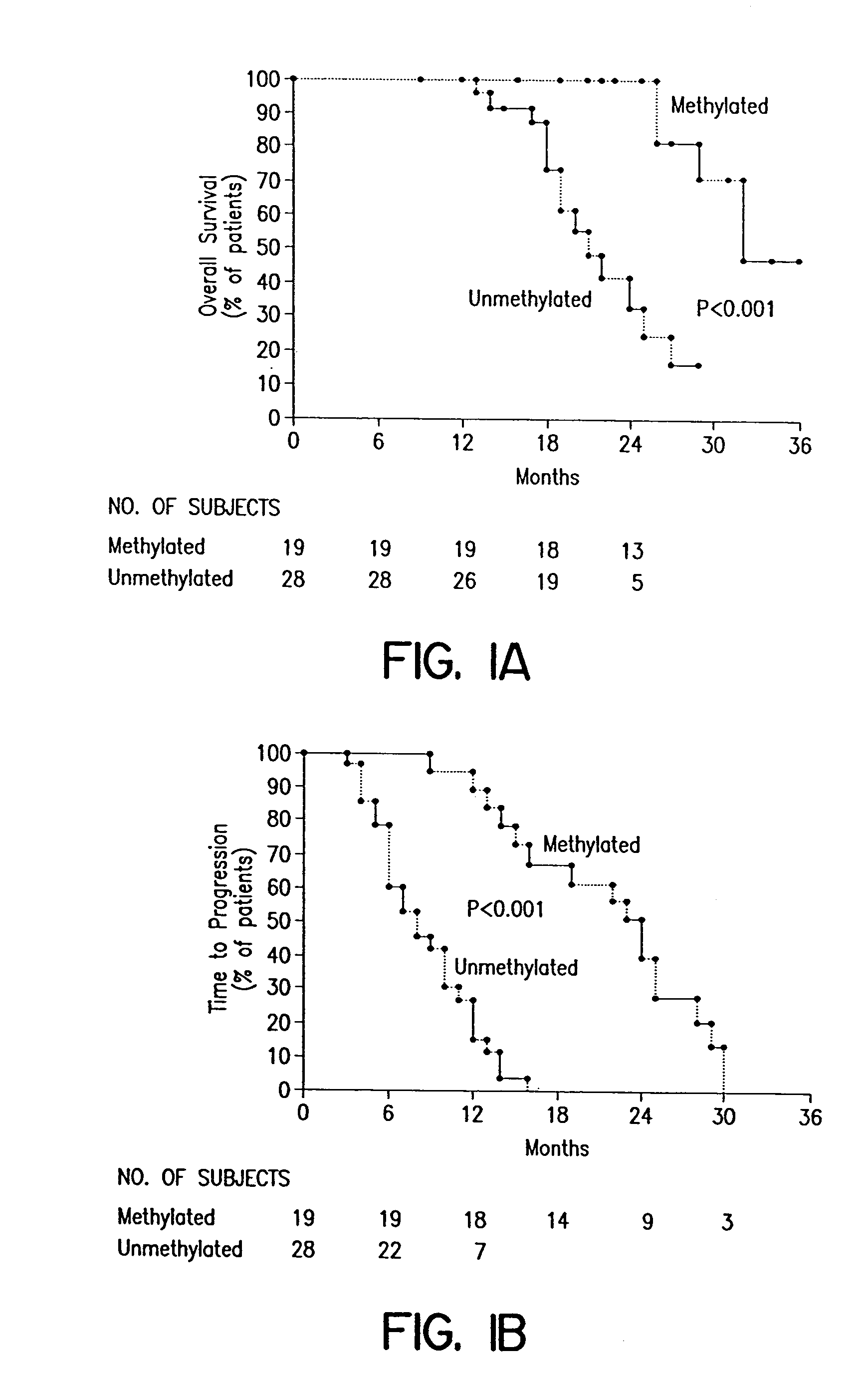Method of predicting the clinical response to chemotherapeutic treatment with alkylating agents
a technology of alkylating agent and clinical response, applied in the field of chemotherapeutic treatment, can solve the problems of low mgmt and inability to survive damage to dna, and achieve the effect of low mgmt levels
- Summary
- Abstract
- Description
- Claims
- Application Information
AI Technical Summary
Benefits of technology
Problems solved by technology
Method used
Image
Examples
example 1
Analysis of Methylation
[0068]DNA was extracted according to standard protocols known to those of skill in the art (see, e.g., Sambrook et al., Molecular Cloning: a Laboratory Manual, 2nd Ed.; Cold Spring Harbor Laboratory Press, Plainview, N.Y., 1998, herein incorporated by reference). Methylation patterns in the CpG island of MGMT were determined by chemical modification of unmethylated, but not methylated, cytosines to uracil. Methylation-specific polymerase chain reaction (PCR) was performed with primers specific for either methylated or the modified unmethylated DNA, as previously described (Esteller, et al. Cancer Res 1999; 59:793-797; incorporated herein by reference in its entirety; and Herman et al. Proc Natl Acad Sci U S A 1996;93:9821-9826; incorporated herein by reference in its entirety). DNA (1 μg) was denatured with sodium hydroxide and modified with sodium bisulfite. DNA samples were then purified with the Wizard DNA purification resin (Promega, Madison, Wis.), again ...
example 2
[0069]Continuous variables were compared with the use of Student's t-test. Contingency tables were analyzed by Fisher's exact test. Disease-free and overall survival curves were estimated by the Kaplan-Meier method and were compared with the use of the log-rank test. Multivariate survival analyses were performed with the Cox proportional-hazards model, and proportional-hazards assumptions were checked with the use of Schoenfeld residuals and graphic methods. Descriptive or stratified analyses always preceded parametric modeling in order to confirm that the assumptions underlying the models were met. The results are reported as two-sided P values with 95 percent confidence intervals. Analyses were performed with the use of JMP software (version 3.1, SAS Institute, Cary, N.C.) and Stata software (version 6.0, Stata, College Station, Tex.).
example 3
Brain Tumor Subjects and Specimens
[0070]Specimens of brain tumors from 47 consecutive subjects referred to the University Hospital of Navarre, in Pamplona, Spain, between April 1993 and November 1998 were studied. All the subjects provided written informed consent. All had histologically verified tumors: Eighteen had an anaplastic astrocytoma, and 29 had a glioblastoma multiforme. Subjects were 38 to 70 years old (median age at diagnosis, 55 years); 30 were men, and 17 were women. Tumor specimens were obtained by resection or biopsy performed before the initiation of treatment with radiation and chemotherapy and were immediately frozen and stored at −80° C. All subjects were treated with intraarterial cisplatin (50 mg per square meter of body-surface area), whole-brain radiotherapy, and a median of three courses of intravenous carmustine (1,3-bis(2-chloroethyl)-1-nitrosourea, or BCNU; 100 mg per square meter) given at four-week intervals. Fifteen of the subjects also underwent autol...
PUM
| Property | Measurement | Unit |
|---|---|---|
| temperatures | aaaaa | aaaaa |
| temperature | aaaaa | aaaaa |
| temperature | aaaaa | aaaaa |
Abstract
Description
Claims
Application Information
 Login to View More
Login to View More - R&D
- Intellectual Property
- Life Sciences
- Materials
- Tech Scout
- Unparalleled Data Quality
- Higher Quality Content
- 60% Fewer Hallucinations
Browse by: Latest US Patents, China's latest patents, Technical Efficacy Thesaurus, Application Domain, Technology Topic, Popular Technical Reports.
© 2025 PatSnap. All rights reserved.Legal|Privacy policy|Modern Slavery Act Transparency Statement|Sitemap|About US| Contact US: help@patsnap.com



